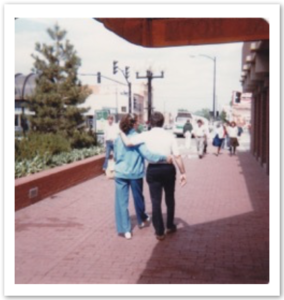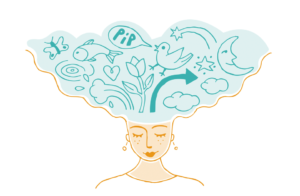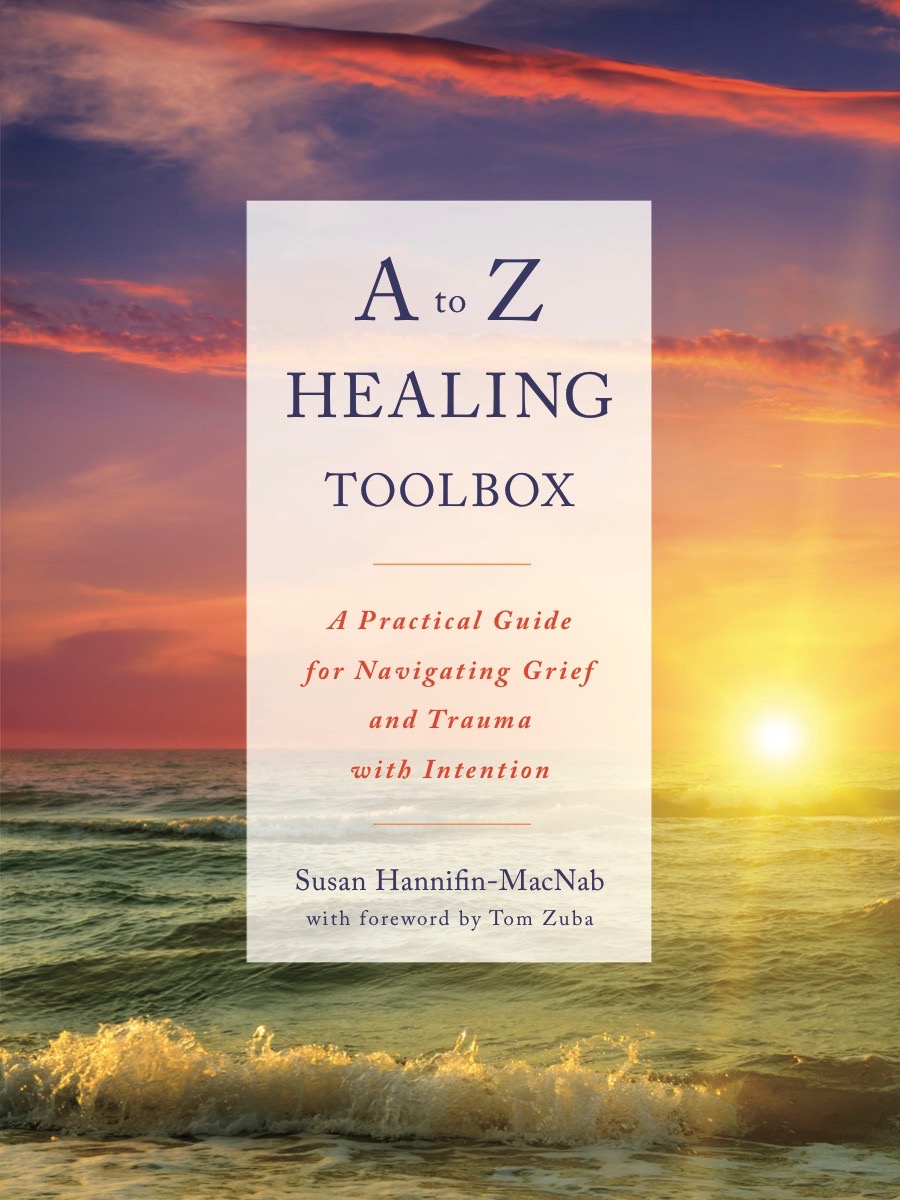Gail Gerbie is no stranger to grief and trauma. Both of her parents died on the same day- from different circumstances. She explains, “After their deaths and side-by-side burial, horrifying images would take over the movie screen in my head. There were times when images would rise out of nowhere and knock me to my knees.” Gail discovered that harnessing the power of positive IMAGERY was what facilitated the healing of those unwanted images.
In the following essay, Gail Gerbie- Licensed Marriage and Family Therapist- explains to the A2Z community why IMAGERY can be a beneficial tool for us, as well. Gail integrates Sandplay Therapy, Symbolic Imagery, Expressive Arts Therapy, Narrative Therapy and Animal Assisted Therapy in her work with clients learning to live with grief and trauma.
IMAGERY
by Gail Gerbie, LMFT
Licensed Marriage and Family Therapist

In my work, I am often asked, “How do I get the horrible, insane images out of my head?”
I then ask, “Do you mean the images of the scenes you have actually witnessed or the images that your brain created?” Inevitably, the answer is BOTH! Then the conversations usually proceeds like this:
I take a deep breath, say a short silent prayer, and usually say, “Well…when my parents died, I saw things and imagined things I never thought possible.”
“Wait, what? Did your parents die in an accident?”
“No, that’s not what happened, but they did die within hours of each other.”
“What? Really? I thought that only happened in movies.”
“Yes, this happened in real life…my life…and here is a short version of the story: My Dad was diagnosed with cancer. My Mom had advancing dementia. I always remember my Mom saying, ‘I love your father so much that I don’t want to live a single day on this earth without him.’ And that is exactly what happened. The day my Dad was expected to die, my Mom got out of bed, went to the bathroom and died of a massive heart attack. My Dad died later that night.”
If you are reading this then you know the real story wasn’t so short and sweet. The progression of Dad’s cancer was awful. Watching his robust body wither away while his brilliant doctor-mind tried to outsmart his cancer was heartbreaking. Being with Mom was equally difficult. She had advancing dementia and could not retain anything. Day and night she would ask, “Sweetheart, what’s going on? Why are all these people in my bedroom? Why isn’t your Dad getting out of bed?” and every time we answered truthfully, we witnessed her suffering as she heard and re-heard the horrible news that the love of her life had terminal cancer.
Those months- and especially the last day of my parents’ lives- were filled with scenes beyond the imagination of any hollywood writer. The scenes that played in my mind could only be temporarily stopped with distraction. After their deaths and side-by-side burial, horrifying images would take over the movie screen in my head. There were times when images would rise out of nowhere and knock me to my knees. I was seeing a good therapist and using my strong support network yet I needed something more to stop the debilitating images.
I discovered that harnessing the power of IMAGERY was what facilitated healing of the unwanted images.
Why does imagery work to heal the horrific images associated with trauma and loss?
The brain is divided into two hemispheres that communicate with one another.
The left brain is the side where the “L” things are situated: LOGIC, LINEAR THINKING, LANGUAGE.
The right brain is where our NON-VERBAL things are located: FEELINGS, IMAGES, SYMBOLS, CREATIVITY, COLOR
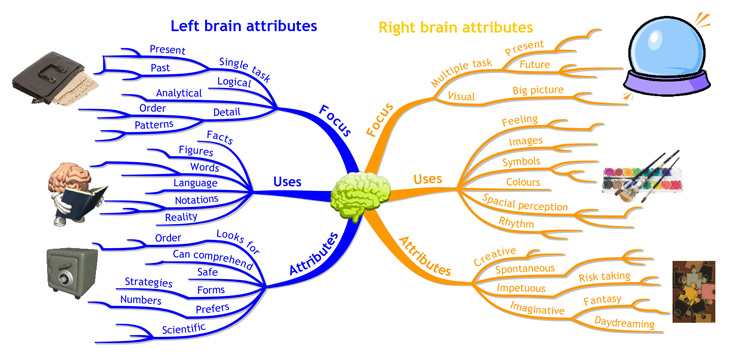 https://www.illumine.co.uk/2011/02/left-brain-or-right-brain/
https://www.illumine.co.uk/2011/02/left-brain-or-right-brain/
When trauma occurs and the sympathetic nervous system (“fight or flight”) goes into high gear, the brain spends most of its energy focusing on trying to make a plan, figuring out what to do, asking a million questions, basically; trying to make sense of it all. In the meantime, without language, the right brain doesn’t have a way to express itself other than being flooded and overwhelmed with emotion and imagery.
If we can focus the right brain and use its powerful attributes, we can bring the two hemispheres back into balance. To do that, the sympathetic nervous system needs to be slowed down to allow the parasympathetic nervous system (digestion, rest, pleasure) to have a chance to get in balance. If you give yourself the time and space to use IMAGERY as a tool, the mind can refocus, replacing the painful images with ones that are constructive and healing. This is a way to grow and make meaning out of trauma.
By the way, often the mere suggestion of trying some of these methods may create resistance. The logical side of the brain may scream and dismiss these ideas because it is too busy doing the important job of trying to “think” its way out of its pain. Personally, I know this to be true. Despite my artistic and creative side, my head was insulted when these ideas were suggested to me. I thought I was smart enough to “figure it out” and win the inner grief battle. Unfortunately, those kind of smarts are only a part of the brain power we have available to help us heal. There is a wealth of healing power when we use the right side of the brain which requires quieting the logical brain. For me, symbolic IMAGERY, resting the parasympathetic nervous system using creativity, and mindfully refocusing my personal camera were the tools that effectively eased my pain and traumatic images.
If you are challenged by lingering internal images, here are number of techniques that helped me. I suggest you try a few and see what works for you. Some of these methods came to me from fellow grievers, some were suggested by counselors and hospice, and some I discovered on my own by trial and error. Remember, the process of grief is a very individual one. What works for you today, might not work tomorrow and what works for some may not work for others. Keep experimenting, and fill your personal toolbox with what works for YOU.
-
“MOVE THE CAMERA LENS”
When your mind fixates on an image, imagine that your mind’s eye is a camera pointed at the image you are seeing. Take a deep breath. Then, very slowly move the camera back or forward and look at a different scene. Use “real” scenes from your life that you remember and feel “normal” to you. I think everyday scenes are the easiest to access. You get to decide where the camera focuses, it is your camera. Here’s an example:My mom died in her bathroom. I continued to be haunted with the image of her body in the bathroom and my dad watching and dying at the same time. I catch myself consumed with feelings the image evokes. I take a deep breath and slowly move the lens of my camera to a different scene. Now, I see my mom sitting in her lovely bathroom on her vanity chair. She is putting on makeup to “go out for a bite’ with my dad. She is in her normal routine of “putting on her face.” I see her manicured hands, her beautiful face in the mirror, and her collection of fancy perfume bottles on the shelf behind her. When I look at this scene, I am able refocus on my own day-to-day life and feel a greater sense of peace.
-
GUIDED IMAGERY
Guided imagery is a technique that allows you to go on a mental journey by using all of your senses. There are many books on guided imagery, CD’s and YouTube videos available online. My personal favorite is the Pink Bubble Technique. It can be found here: (http://balancedwomensblog.com/pink-bubble-visualization-technique)
-
MEDITATION
There are many different types of meditations that use IMAGERY. If you google “meditation” or “meditations for grief” you will find books, different philosophies and techniques, voice guided methods, YouTube links, iTunes playlists, and even smartphone apps. My personal favorite: WALKING. I walk “mindfully” with my dog. While on our walks, I pay close attention to EVERYTHING. Every step, every crack of my ankle, every cloud, every leaf, every sound, every smell….well, you get the idea. You can check out:
-
COLORING AND ZENTANGLE
Years ago, I discovered adult coloring books and they helped transform my mental pictures. Today, the market is full of choices and designs. All you need is a coloring book and colored pencils or crayons. Check out these 4 sites for coloring books that may resonate with you!
-
SOUL COLLAGE
www.soulcollage.com to find Soul Collage facilitators and workshops in your area
-
ILLUSTRATED DISCOVERY JOURNAL
After trauma and significant loss visits, we are forever altered. We feel like different people and don’t really recognize ourselves. The Illustrated Discovery Journal is an IMAGE-BASED way to discover your new self by discovering what you like now, what appeals to your new self, and a what to you enjoy. Go to www.amazon.com to find a journal where the NEW YOU becomes the illustrator.
-
SANDPLAY THERAPY
Two years after my parents died, I went back to school to fulfill a lifelong dream of becoming a therapist. While studying, I discovered Sandplay Therapy and its potential to heal trauma and grief. To facilitate my own healing journey, I began my own inner work with a Certified Sandplay Therapist in San Diego and enrolled in classes to learn more about the work. Today, I am now a Licensed Marriage and Family Therapist and Sandplay Practitioner in private practice.
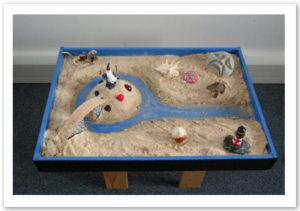 Sandplay therapy is a non-verbal, non-rational form of therapy where clients use miniature figures to create scenes in a sand box. This method has been found to be very gentle and effective in the healing of grief, loss, trauma and PTSD. To learn more about Sandplay Therapy or to find a Sandplay therapist near you please check out these resources:
Sandplay therapy is a non-verbal, non-rational form of therapy where clients use miniature figures to create scenes in a sand box. This method has been found to be very gentle and effective in the healing of grief, loss, trauma and PTSD. To learn more about Sandplay Therapy or to find a Sandplay therapist near you please check out these resources:- www.sandplay.org
- www.junginla.org/education/what_is_sandplay
- Letter “R – Right Brain Release” in the A2Z Healing Toolbox to see a Sandplay video.


